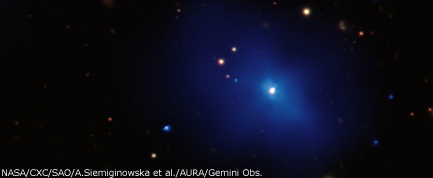Distant Galaxy Cluster Has a Cold Quasar Heart

A space telescope has spotted a strange, distant galaxy cluster with a cosmic heart that is surprisingly cold.
NASA's Chandra X-ray Observatory snapped an image of the cluster, which is about 8 billion light-years from Earth. The cluster surrounds a bright object known as a quasar. This particular quasar is called 3C 186, making it the farthest galaxy cluster with a quasar ever seen. [X-ray image of the cold quasar]
Quasars form at the central regions of some galaxies, where giant black holes gobble up matter so furiously that the remaining stuff around them generates tremendous energy transmissions that span the entire electromagnetic spectrum, including radio waves, light and X-rays. They are some of the brightest objects in the universe.
But the heart of the galaxy cluster studied by the Chandra observatory is only cold in astronomical terms.
The gas at the cluster's center is a mere 30 million degrees Fahrenheit (16.7 million degrees Celsius), while stuff at the outskirts tops out around 80 million degrees Fahrenheit (44.4 million Celsius). While that seems scorching hot to the average human, for quasars it's positively chilly, researchers said.
This drop in temperature occurs because intense X-ray emission from the gas nearer the core cools it down, the researchers added.
The galaxy cluster surrounding quasar 3C 186 is the most distant one ever found containing a quasar. It's also the most distant cluster ever observed with a cooling core. The faraway object could therefore provide insight into how quasars form and clusters grow, researchers said.
Get the world’s most fascinating discoveries delivered straight to your inbox.
Because it took 8 billion years for the cluster's light to reach Chandra's instruments, researchers are seeing it as it appeared when the universe was still relatively young — less than half its current age of about 13.7 billion years.
Previous observations have revealed large numbers of clusters with strong cooling cores closer to Earth, less than about 6 billion light-years. But they appear to be more rare the farther away researchers look.
One reason for this may be that more distant galaxy clusters — which are younger, since astronomers are seeing them at an earlier point in the universe's history — merge more often with other clusters or galaxies, researchers said.
These mergers would destroy the cooling cores. When coupled with the fact that it takes cooling cores a long time to form, this would make them rare in the earlier stages of the universe.
This cluster was found fortuitously via a relatively modest Chandra survey. So it's possible that many other similar objects exist at large distances, researchers said.
The picture of the cluster surrounding quasar 3C 186 is a composite. It includes a new image from Chandra showing X-ray emissions from gas surrounding the point-like quasar near the center. Optical data from the Gemini telescope in Chile contribute views of nearby stars and galaxies.
The research is detailed in the Oct. 10 issue of the Astrophysical Journal.
- Top 10 Strangest Things in Space
- Video: The Black Hole That Made You Possible
- Video: Quasar Interaction
This article was provided by SPACE.com, a sister site of LiveScience.com.



